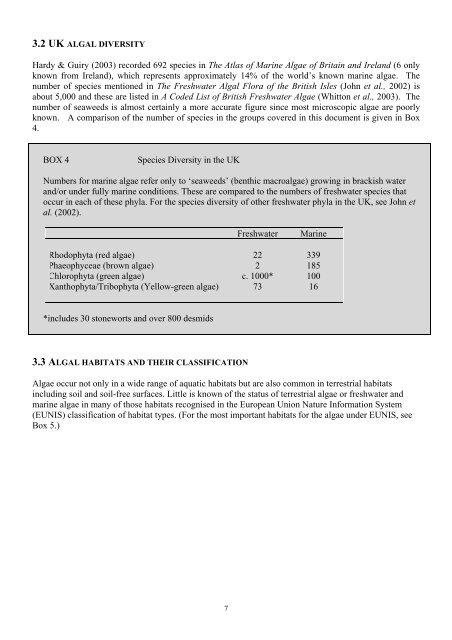Important Plant Areas for algae - Natural History Museum
Important Plant Areas for algae - Natural History Museum
Important Plant Areas for algae - Natural History Museum
Create successful ePaper yourself
Turn your PDF publications into a flip-book with our unique Google optimized e-Paper software.
3.2 UK ALGAL DIVERSITY<br />
Hardy & Guiry (2003) recorded 692 species in The Atlas of Marine Algae of Britain and Ireland (6 only<br />
known from Ireland), which represents approximately 14% of the world’s known marine <strong>algae</strong>. The<br />
number of species mentioned in The Freshwater Algal Flora of the British Isles (John et al., 2002) is<br />
about 5,000 and these are listed in A Coded List of British Freshwater Algae (Whitton et al., 2003). The<br />
number of seaweeds is almost certainly a more accurate figure since most microscopic <strong>algae</strong> are poorly<br />
known. A comparison of the number of species in the groups covered in this document is given in Box<br />
4.<br />
BOX 4<br />
Species Diversity in the UK<br />
Numbers <strong>for</strong> marine <strong>algae</strong> refer only to ‘seaweeds’ (benthic macro<strong>algae</strong>) growing in brackish water<br />
and/or under fully marine conditions. These are compared to the numbers of freshwater species that<br />
occur in each of these phyla. For the species diversity of other freshwater phyla in the UK, see John et<br />
al. (2002).<br />
Freshwater<br />
Marine<br />
Rhodophyta (red <strong>algae</strong>) 22 339<br />
Phaeophyceae (brown <strong>algae</strong>) 2 185<br />
Chlorophyta (green <strong>algae</strong>) c. 1000* 100<br />
Xanthophyta/Tribophyta (Yellow-green <strong>algae</strong>) 73 16<br />
*includes 30 stoneworts and over 800 desmids<br />
3.3 ALGAL HABITATS AND THEIR CLASSIFICATION<br />
Algae occur not only in a wide range of aquatic habitats but are also common in terrestrial habitats<br />
including soil and soil-free surfaces. Little is known of the status of terrestrial <strong>algae</strong> or freshwater and<br />
marine <strong>algae</strong> in many of those habitats recognised in the European Union Nature In<strong>for</strong>mation System<br />
(EUNIS) classification of habitat types. (For the most important habitats <strong>for</strong> the <strong>algae</strong> under EUNIS, see<br />
Box 5.)<br />
7

















